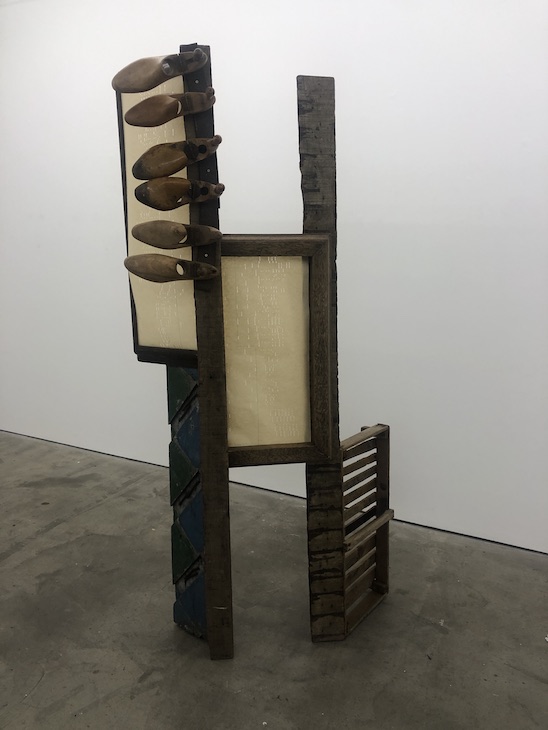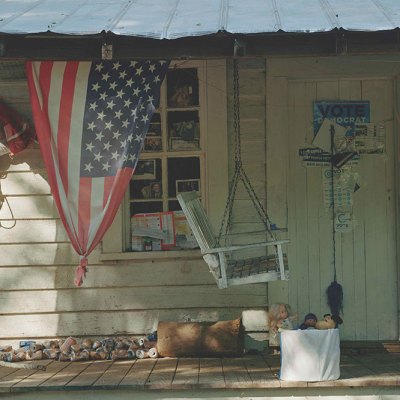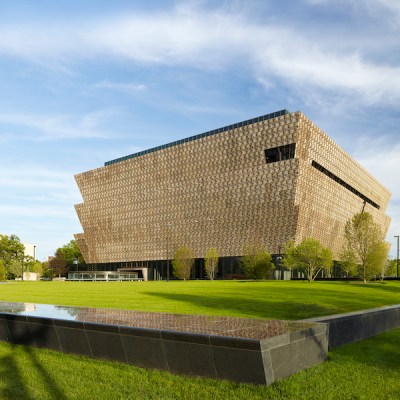‘If you look at that piece of music I did about waking up in a fucked-up America,’ Lonnie Holley tells me, ‘it’s just coming more and more to be truth around the globe.’ The sculptor and musician is speaking to me in mid March from the front seat of a car parked outside his home in Atlanta, just as the city is locking down against coronavirus. On 8 June, as I arrange a second Skype call with Holley’s manager Matt Arnett, these words are on my mind – not to mention the song itself; a visceral sermon on the ills of the modern world from the LP MITH (2018), delivered in a voice that is by turns guttural and crooning. Holley opens the car door and takes his seat beside Arnett, watching the end of George Floyd’s funeral play out on his phone. ‘The truth,’ he says, ‘is contagious.’
Holley is an artist who gives the impression of being both out of time and just in time. There is a mythic quality to the way he thinks and talks, framing the events of the past as explanations for the present. You get the sense that nothing could surprise him. In 1997, Holley’s home outside of Birmingham, Alabama, with its sprawling, two-acre sculpture yard that he had been populating for some 18 years with his paintings, sandstone carvings and elaborate found-object assemblages, was bulldozed to make way for an expansion to Birmingham Airport. Holley returns to this event when I ask him about the toppling of statues in Black Lives Matter protests around the world. ‘Did not my art have to be destroyed in order for me to move forward?’
From the Beginning To The End To The Beginning (1985), Lonnie Holley. Souls Grown Deep Foundation. Photo: Stephen Pitkin/Pitkin Studio. © Lonnie Holley

Holley was born in Jim Crow-era Alabama in 1950, the seventh of 27 children. By his own account, he was swapped into another family by the woman who informally adopted him for a pint of whiskey at the age of four, and pronounced brain dead after being run over at seven. At 11, he was sent to an infamous juvenile centre for black children in Montgomery County, where he picked up trash from the roadside; in his teens, his grandmother taught him to hunt for scrap to sell at flea markets. He later worked as a short-order cook at Disney World, and then as a gravedigger.
At the age of 29, his young nephew and baby niece were killed in a house fire. He took a piece of sandstone that was standing in the yard of his sister’s house, and with his grandfather’s cross-cut saw fashioned a tombstone. ‘That was what started me into making art,’ he tells me. ‘Because I didn’t know what art really was.’ He continued carving – regal figures, redolent of ancient Egyptian sculpture, or faces with features schematised like masks – and began soon afterwards to make his first assemblages. By 1981 his work was on display at the Birmingham Museum of Art and the Smithsonian; by the middle of the 1980s, the collector William S. Arnett (Matt’s father) had begun to champion his art, alongside that of his close friends Thornton Dial, Purvis Young and Joe Minter, among others. These were the beginnings of the Souls Grown Deep Foundation, founded by Arnett in 2010 to represent the work of African American artists who had grown up outside the usual mechanisms of the art world, who had been shaped instead by the folk traditions of the American South.
What”s on the Workhorse Today? (1995), Lonnie Holley. Souls Grown Deep Foundation. Photo: Stephen Pitkin/Pitkin Studio. © Lonnie Holley

Holley makes his sculptures – like he makes his music, which he began recording at home in the mid 1980s, releasing his first record in 2012 – by improvising. With rope or wire, he yokes together detritus he has picked up in junkyards or by the side of the road. The resulting formations are abstract, but given symbolic power by the objects themselves: busted appliances, worn-out musical instruments, frayed clothes. In things deemed no longer valuable by others, Holley sees both a history of former use, and the potential for new meaning. An upcoming exhibition at Edel Assanti gallery in London – planned for March, delayed now until January 2021 – will include a recent series of sculptures that riff on the idea of how information is framed. In First and Last Score, six faded women’s heels are stuck to an upright wooden post. Beneath them is a broken picture frame, in which there is a piece of faded paper – Holley explains that it is ‘an old piano roll’, of the kind that might once have animated an automatic pianola. The shoes, protruding outwards, take on the appearance of tuning pegs – the sculpture as a whole looks like a jumbled junkyard instrument, but one instilled with the melancholy of silence, where once there was music and dancing. ‘It’s to show that we as humans are still trying to get an understanding of information that is beyond us,’ Holley says.
First and Last Score (2020), Lonnie Holley. Courtesy Edel Assanti

Holley refers to himself, and to his contemporaries among the Souls Grown Deep artists, as ‘the foot soldiers of art’. He did not begin to make art in the hope of recognition, yet recognition for Holley has steadily grown over the last four decades. His work has been displayed in the White House and at the United Nations; he has performed to acclaim on stage with bands such as Animal Collective, and there is now a fourth LP in the offing for this summer. However, none of this has changed his understanding of the purpose of art. ‘We’ve been using these different types of materials by any means that we can to bring recognition to the human cause. Think about the trash – how much more debris has been added to the world [during the BLM protests]? And who will help to pick it up? We’re still depending on somebody to make some kind of sense of it – to recycle it.’ His art invites us to participate in this same meditative process of putting a broken world back together, piece-by-piece.
For more information, visit Edel Assanti’s website.



